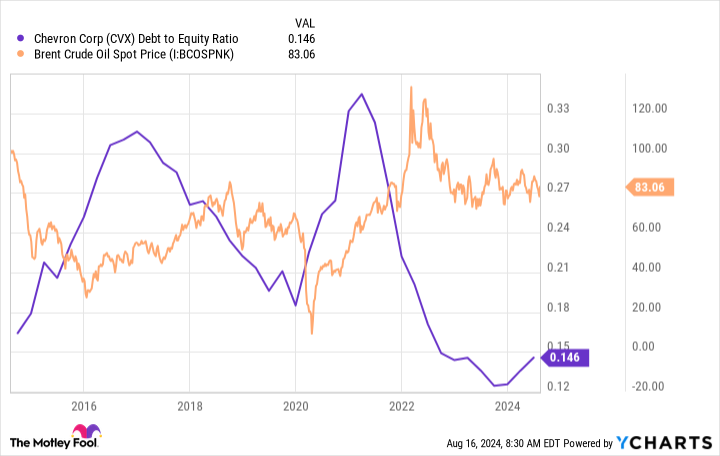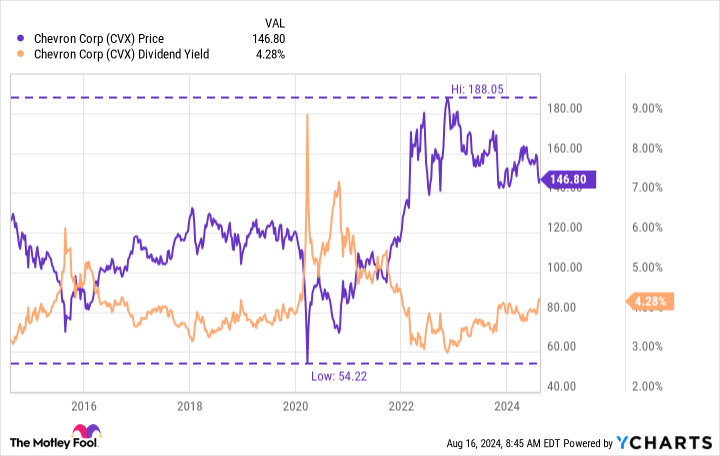Should You Buy Chevron While It's Below $150?
Chevron (NYSE: CVX) has a lot going for it as an energy investment, not least of which is the dividend, which has been increased annually for 37 consecutive years and supports a lofty 4.4% dividend yield at present. With the stock more than 20% below its most recent highs, should you buy Chevron? Here are some important factors to consider before making the final call.
What does Chevron do in the energy industry?
The headline is actually a trick question because Chevron pretty much does everything, which is why it is classified as an integrated energy company. But to be more specific, it has operations in the upstream segment (energy production), the midstream arena (pipelines and other transportation and storage infrastructure), and the downstream niche (chemicals and refining). Each segment of the broader energy sector operates a little differently and has different market dynamics.
Putting upstream, midstream, and downstream businesses all under one roof not only creates a diversified company, which is further enhanced by Chevron's global reach, but tends to help soften the ups and downs of the energy cycle. Commodity prices are the main driver of Chevron's top and bottom lines, but the inherent swings won't be quite as material as they would be if it were solely focused on the upstream.
Chevron is also keenly focused on the strength of its balance sheet. To put a number on that, Chevron's debt-to-equity ratio is a minuscule 0.15 today. That would be a low number for any company, but it also happens to be the lowest figure relative to Chevron's closest peers. This gives Chevron more leeway to take on leverage to support its business and dividend during the inevitable oil downturns it will face. Simply put, Chevron is a conservative way to invest in the energy sector.
Is Chevron a buy under $150?
Chevron's stock is under $150 today, which represents a roughly 20% decline from the recent price peak of roughly $188 per share in late 2022. That could be seen as a solid entry point for dividend investors who want to add energy exposure to their portfolios, noting the stock's attractive 4.4% yield. After all, the S&P 500 index is only yielding around 1.2% or so, and the average energy stock, using Energy Select Sector SPDR ETF as a proxy, is yielding about 3.1%.
Now add in Chevron's strong financial position, diversified business, and long history of weathering energy downturns while continuing to reward investors with regular dividend increases. You can see where a conservative type would be making a wise choice to buy the stock if they are looking for an energy investment right now.
But there's one problem: Oil prices are actually fairly high right now. Sure, they've been higher, but they've also been a lot lower. Given the nature of the oil industry, it is highly likely that Chevron will have to deal with materially lower energy prices at some point in the not-too-distant future.
Chevron is ready, noting its very low debt-to-equity ratio, but that won't change the fact that revenue and earnings fall when energy prices decline. That, in turn, will lead investors to sell the stock.
In fact, over the past decade, Chevron's stock has dipped below $80 a share three times. The dividend yield, meanwhile, has risen as high as 9% at one point. That was an extreme peak related to the coronavirus pandemic. But 6% isn't out of bounds, having been reached three times as well.
It wouldn't be at all shocking to see a deep oil downturn that leads to a deep drawdown in Chevron's stock and pushes the yield up to materially more attractive levels. Or to put it another way, if you are looking to buy Chevron at a bargain price, you'll want to wait until the next big oil sell-off.
Chevron is a good company
Here's the thing: For long-term investors with an income focus, Chevron is probably a good choice right now. You won't be getting the best possible price, but you are probably buying it at a fair level if you add the stock below $150.
However, if you are willing to watch and wait, you can probably buy it at a much better price at some point in the future, given the inherent volatility of the energy sector. The one caveat here is that you should get to know the company today and create a concrete plan for when you want to buy it (perhaps when the yield hits 6%).
Indeed, the best time to buy Chevron is likely to be when the fear of owning it seems highest, and if you don't plan ahead, fear might lead you to miss the opportunity.
Should you invest $1,000 in Chevron right now?
Before you buy stock in Chevron, consider this:
The Motley Fool Stock Advisor analyst team just identified what they believe are the 10 best stocks for investors to buy now… and Chevron wasn’t one of them. The 10 stocks that made the cut could produce monster returns in the coming years.
Consider when Nvidia made this list on April 15, 2005... if you invested $1,000 at the time of our recommendation, you’d have $779,735!*
Stock Advisor provides investors with an easy-to-follow blueprint for success, including guidance on building a portfolio, regular updates from analysts, and two new stock picks each month. The Stock Advisor service has more than quadrupled the return of S&P 500 since 2002*.
*Stock Advisor returns as of August 12, 2024
Reuben Gregg Brewer has no position in any of the stocks mentioned. The Motley Fool has positions in and recommends Chevron. The Motley Fool has a disclosure policy.
Should You Buy Chevron While It's Below $150? was originally published by The Motley Fool


